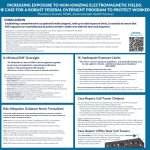
For the better part of 20 years, Peter Arlein worked as a professional ski technician, waxing skis across Colorado.
Working occasionally in smaller shops with poor ventilation, he breathed in fumes released by the waxes. “The backroom is pretty cramped,” Arlein told EHN. “In the winter, you don’t want to have the door open because it’s freezing. The ventilation is not great.”
When he learned what ski wax was made of, though, he re-thought his career path. “It was kind of an ‘aha’ moment,” he said.
Most ski wax is a petroleum product filled with chemicals that can be harmful to human health. Some high-end wax can contain PFAS–a type of petroleum derivative added to make skis glide faster. PFAS, which stands for per- and poly-fluoroalkyl substances, are toxic chemicals linked to health problems such as certain types of cancer, reproductive issues, and birth defects.
“There was definitely a concern about personal health, for myself and my co-workers,” said Arlein. In response, he began a new venture to create a plant-based, non-toxic ski wax, called mountainFLOW.
Before starting his company, Arlein was one of the many workers across the country exposed to PFAS through their jobs. While PFAS exposure has been a concern in industries like firefighting and chemical manufacturing, there is mounting evidence that workers in other industries–including the auto industry, construction industry, and cleaning industry–are also exposed to the chemicals, sometimes without their knowledge. And workplace regulations may be inadequate for protecting workers.
“We need to know how much of our worker population is exposed to these,” Leena Nylander-French, the director of the NC Occupational Safety and Health Education and Research Center at the University of North Carolina, told EHN. “Can these exposures be prevented?”
PFAS in the ski industry
Arlein’s concerns are backed up by science, such as a 2010 paper that tested the blood levels of PFAS in professional ski waxers in Norway. The study found that professional ski waxers had up to 25 times as much PFAS in their blood as people in the general population. The median concentration of PFAS in the waxers’ blood was also 10 times higher than the “tolerable weekly intake” of PFAS set by the European Food Safety Authority.
Line Småstuen Haug, an author on the study and a senior scientist at the Norwegian Institute of Public Health, said waxers they studied reported bouts of “Teflon fever” when they had been waxing a lot of skis. Teflon is a brand name of a chemical coating that contains PFAS that is sometimes used in ski waxes and other consumer products, such as non-stick cookware.
“This is a usage which I think is possible and important to get rid of,” she told EHN. “It creates a lot of exposure that is definitely unnecessary.”
The ski industry has been trying to get rid of PFAS-containing waxes: In 2020, the International Ski Federation, an international governing body for ski racing, banned PFAS waxes in professional races.
What are PFAS?
The ban, however, left U.S. ski shops with a surplus of PFAS-containing waxes that are still in use today because shops aren’t sure how to get rid of them. “It is being used recreationally because people are sitting on all of this inventory,” said Arlein. “It’s too expensive to throw out.”
According to Arlein, the level of exposure depends on the type of ski resort, the ventilation in place, and whether personal protective equipment is worn. Larger resorts, for example, are more likely to have higher-end ventilation systems in their ski shops. With PFAS-containing waxes, said Arlein, workers are usually required to wear respirators. “I can’t say how many people actually follow that,” he said. “I know it’s not everybody.”
Arlein’s company, mountainFLOW, is developing a buy-back program to get the PFAS-containing waxes out of ski shops.
Four of the 13 ski resorts contacted for this article stated they had phased out the use of PFAS-containing waxes, or had never used the waxes in their ski shops. The other nine resorts did not respond to requests for comment.
Though professional ski shops at these large resorts no longer use waxes that contain PFAS, their health effects can still linger in the bodies of workers, as shown by a 2017 paper that studied occupational exposure to PFAS in upstate New York. The study, which observed 154 people who had spent years working in an industrial area of the state, found that those exposed to PFAS chemicals in the workplace had elevated blood levels of PFAS for a median of 28 years after they had been exposed.
“These chemicals are persistent,” Kurunthachalam Kannan, an author on the study and a professor at the New York University Grossman School of Medicine, told EHN. “If you have higher exposures, higher levels in your body, it takes a longer time to clear.”
PFAS in the transportation industry

PFAS are also widely used in the transportation industry, according to a paper from NYU researchers that found PFAS in 18 of 18 automotive lubricants tested. The highest levels of PFAS were found in a brand of hydraulic fluid marketed for use in vehicles, boats, elevators, and construction equipment. PFAS are also typical components in fuel lines, brake lines, valves, and batteries in cars.
Kannan, who is also an author on the automotive study, said that the levels of PFAS in these substances probably put workers who are handling these oils and lubricants daily, like auto mechanics, at risk of exposure and possible health effects.
Kannan is also concerned about airport workers who spray de-icing fluids, which contain PFAS, on planes. These workers, he said, are not always wearing personal protective gear.
In a fact sheet about use of PFAS in the automotive industry, chemical company Chemours, which produces automotive lubricants for a wide variety of applications, wrote that PFAS chemicals used in the industry are “critical technologies with no viable alternatives,” and that they “do not pose a significant risk to human health or the environment when used for their intended purposes.”
Chemours was spun off from chemical company DuPont–the company responsible for widespread pollution of North Carolina’s Cape Fear River with the PFAS chemical GenX–in 2015.
Julie Massaro, the executive director for the Automotive Service Association, a trade association for repair shop workers and owners, said that the ASA was not aware of PFAS as an occupational hazard in the auto industry. However, she said, the ASA is “very supportive of protecting the workers and technicians working on the cars.”
PFAS in construction

The construction industry uses PFAS in roofing coatings, certain paints, some types of flooring materials, sealants, adhesives, and even glass fixtures. According to a report from the Green Science Policy Institute, these products may give building construction workers and those working on home improvement projects elevated exposures.
PFAS chemicals used in these industries and in consumer products eventually make their way to waste streams and can accumulate in soil. The existence of PFAS in soils can pose a risk to construction workers, especially those involved in tunneling or digging projects, according to a 2022 paper out of Swinburne University of Technology in Australia.
Construction workers involved in demolition products are also at risk of PFAS exposure through dust inhalation. Most PFAS in construction materials are chemically inert, said Charley Stevenson, founder of green building service MateriallyBetter. However, the products that contain the chemicals can degrade and accumulate in dust.
Scott Rayburn, a professor of civil and construction engineering and an author on the paper, said that PFAS are rarely discussed by the construction industry.
Neither North America’s Building Trades Unions nor the United Union of Roofers, Waterproofers, and Allied Workers responded to multiple requests for comment.
Widespread PFAS use
PFAS pose a risk to workers in other industries as well. For example, PFAS are added to cleaning products used by professional cleaners and custodians–certain floor waxes or stain-resistant carpet cleaning agents contain PFAS. “Anybody who works in those places will get a full dose because the [cleaning agents] wear off and have to be reapplied,” Ranier Lohmann, a professor of environmental chemistry at the University of Rhode Island, told EHN.
Furniture manufacturers also sometimes add PFAS to products to make them stain-resistant, putting workers at risk, said Stevenson.
Nylander-French is also worried about paper manufacturing. PFAS are used in paper manufacturing in different waterproof coatings; for example, butcher paper used to wrap meat. The environmental wellness blog and community Mamavation tested various paper products last year and found low but detectable levels of fluorine, a PFAS indicator, in certain brands of parchment paper.
Nylander-French said that regulating PFAS use on the occupational side can greatly reduce its prevalence in the environment. “The workers are always exposed first,” she said. “It’s easier to contain the problem when it’s still in containable form than when it’s out in the public.
The federal Occupational Safety and Health Administration does not have specific PFAS regulations. However, employers using PFAS in occupational settings are required to follow general regulations for hazardous chemicals under the Hazard Communication Standard. The standard states that all hazardous chemicals must be accompanied by an informational safety sheet, and that all employers with hazardous chemicals in the workplace must train employees on proper use of the chemicals.
Obstacles to research
Nylander-French said research into occupational exposure is difficult because researchers often lack access to workers.
She is particularly interested in personal protective equipment. Many workers in the industries mentioned in this article wear personal protective equipment, like respirators, when they’re on the job. However, Nylander-French added, little is known about how PFAS actually enter the human body, and whether personal protective equipment like respirators are actually sufficient to protect people.
“There are so many unknowns,” she said. “And I’m not sure that industry itself understands.”
Follow our PFAS testing project with Mamavation at the series landing page.
Want to know more about PFAS? Check out our comprehensive guide.
Have something you want tested for PFAS? Let us know and write us at feedback@ehn.org.
Banner photo credit: Ski wax technician. (Credit: ActiveSteve/flickr)



